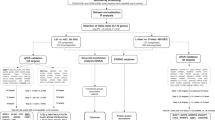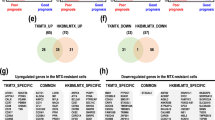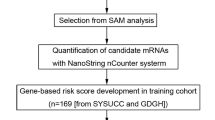Abstract
Over expression of BAALC (brain and acute leukemia, cytoplasmic) predicts an inferior outcome in acute myeloid leukemia (AML) and acute lymphoblastic leukemia patients. To identify BAALC-associated genes that give insights into its functional role in chemotherapy resistance, gene expression signatures differentiating high from low BAALC expressers were generated from normal CD34+ progenitors, T-acute lymphoblastic leukemia (T-ALL) and AML samples. The insulin-like growth factor binding protein 7 (IGFBP7) was one of the four genes (CD34, CD133, natriuretic peptide receptor C (NPR3), IGFBP7) coexpressed with BAALC and common to the three entities. In T-ALL, high IGFBP7-expression was associated with an immature phenotype of early T-ALL (P<0.001), expression of CD34 (P<0.001) and CD33 (P<0.001). Moreover, high IGFBP7-expression predicted primary therapy resistance (P=0.03) and inferior survival in T-ALL (P=0.03). In vitro studies revealed that IGFBP7 protein significantly inhibited the proliferation of leukemia cell lines (Jurkat cells: 42% reduction, P=0.002; KG1a cells: 65% reduction, P<0.001). In conclusion, IGFBP7 was identified as a BAALC coexpressed gene. Furthermore, high IGFBP7 was associated with stem cell features and treatment failure in T-ALL. In contrast to BAALC, which likely represents only a surrogate marker of treatment failure in acute leukemia, IGFBP7 regulates the proliferation of leukemic cells and might be involved in chemotherapy resistance.
This is a preview of subscription content, access via your institution
Access options
Subscribe to this journal
Receive 12 print issues and online access
$259.00 per year
only $21.58 per issue
Buy this article
- Purchase on Springer Link
- Instant access to full article PDF
Prices may be subject to local taxes which are calculated during checkout





Similar content being viewed by others
References
Scott EW, Simon MC, Anastasi J, Singh H . Requirement of transcription factor PU.1 in the development of multiple hematopoietic lineages. Science 1994; 265: 1573–1577.
Scheijen B, Griffin JD . Tyrosine kinase oncogenes in normal hematopoiesis and hematological disease. Oncogene 2002; 21: 3314–3333.
Orkin SH . Transcription factors and hematopoietic development. J Biol Chem 1995; 270: 4955–4958.
Druker BJ, Talpaz M, Resta DJ, Peng B, Buchdunger E, Ford JM et al. Efficacy and safety of a specific inhibitor of the BCR-ABL tyrosine kinase in chronic myeloid leukemia. N Engl J Med 2001; 344: 1031–1037.
Tanner SM, Austin JL, Leone G, Rush LJ, Plass C, Heinonen K et al. BAALC, the human member of a novel mammalian neuroectoderm gene lineage, is implicated in hematopoiesis and acute leukemia. Proc Natl Acad Sci USA 2001; 98: 13901–13906.
Baldus CD, Tanner SM, Ruppert AS, Whitman SP, Archer KJ, Marcucci G et al. BAALC expression predicts clinical outcome of de novo acute myeloid leukemia patients with normal cytogenetics: a Cancer and Leukemia Group B Study. Blood 2003; 102: 1613–1618.
Bienz M, Ludwig M, Leibundgut EO, Mueller BU, Ratschiller D, Solenthaler M et al. Risk assessment in patients with acute myeloid leukemia and a normal karyotype. Clin Cancer Res 2005; 11: 1416–1424.
Baldus CD, Martus P, Burmeister T, Schwartz S, Gokbuget N, Bloomfield CD et al. Low ERG and BAALC expression identifies a new subgroup of adult acute T-lymphoblastic leukemia with a highly favorable outcome. J Clin Oncol 2007; 25: 3739–3745.
Langer C, Radmacher MD, Ruppert AS, Whitman SP, Paschka P, Mrozek K et al. High BAALC expression associates with other molecular prognostic markers, poor outcome, and a distinct gene-expression signature in cytogenetically normal patients younger than 60 years with acute myeloid leukemia: a Cancer and Leukemia Group B (CALGB) study. Blood 2008; 111: 5371–5379.
Kuehnl A, Goekbuget N, Stroux A, Burmeister T, Neumann M, Heesch S et al. High BAALC expression predicts chemoresistance in adult B-precursor acute lymphoblastic leukemia. Blood 2010; 115: 3737–3744, blood-2009.
Baldus CD, Tanner SM, Kusewitt DF, Liyanarachchi S, Choi C, Caligiuri MA et al. BAALC, a novel marker of human hematopoietic progenitor cells. Exp Hematol 2003; 31: 1051–1056.
Gokbuget N, Raff R, Brugge-Mann M, Flohr T, Scheuring U, Pfeifer H et al. Risk/MRD adapted GMALL trials in adult ALL. Ann Hematol 2004; 83 (Suppl 1): S129–S131.
Schwartz S, Rieder H, Schlager B, Burmeister T, Fischer L, Thiel E . Expression of the human homologue of rat NG2 in adult acute lymphoblastic leukemia: close association with MLL rearrangement and a CD10(−)/CD24(−)/CD65s(+)/CD15(+) B-cell phenotype. Leukemia 2003; 17: 1589–1595.
Matutes E, Morilla R, Farahat N, Carbonell F, Swansbury J, Dyer M et al. Definition of acute biphenotypic leukemia. Haematologica 1997; 82: 64–66.
Komor M, Guller S, Baldus CD, de Vos S, Hoelzer D, Ottmann OG et al. Transcriptional profiling of human hematopoiesis during in vitro lineage-specific differentiation. Stem Cells 2005; 23: 1154–1169.
Haferlach T, Kohlmann A, Basso G, Bene MC, Chiaretti S, Downing JR et al. The clinical utility of microarray-based gene expression profiling in the diagnosis and sub-classification of leukemia: final report on 3252 cases from the international MILE study group. Ash Annual Meeting Abstracts 2008; 112: 753.
Mills KI, Kohlmann A, Williams PM, Wieczorek L, Liu WM, Li R et al. Microarray-based classifiers and prognosis models identify subgroups with distinct clinical outcomes and high risk of AML transformation of myelodysplastic syndrome. Blood 2009; 114: 1063–1072.
Dimri GP, Campisi J . Molecular and cell biology of replicative senescence. Cold Spring Harb Symp Quant Biol 1994; 59: 67–73.
Jaatinen T, Hemmoranta H, Hautaniemi S, Niemi J, Nicorici D, Laine J et al. Global gene expression profile of human cord blood-derived CD133+ cells. Stem Cells 2006; 24: 631–641.
Toren A, Bielorai B, Jacob-Hirsch J, Fisher T, Kreiser D, Moran O et al. CD133-positive hematopoietic stem cell ‘stemness’ genes contain many genes mutated or abnormally expressed in leukemia. Stem Cells 2005; 23: 1142–1153.
Vorwerk P, Wex H, Hohmann B, Oh Y, Rosenfeld RG, Mittler U . CTGF (IGFBP-rP2) is specifically expressed in malignant lymphoblasts of patients with acute lymphoblastic leukaemia (ALL). Br J Cancer 2000; 83: 756–760.
Doepfner KT, Spertini O, Arcaro A . Autocrine insulin-like growth factor-I signaling promotes growth and survival of human acute myeloid leukemia cells via the phosphoinositide 3-kinase/Akt pathway. Leukemia 2007; 21: 1921–1930.
Greenberg P, Cox C, LeBeau MM, Fenaux P, Morel P, Sanz G et al. International scoring system for evaluating prognosis in myelodysplastic syndromes. Blood 1997; 89: 2079–2088.
Mutaguchi K, Yasumoto H, Mita K, Matsubara A, Shiina H, Igawa M et al. Restoration of insulin-like growth factor binding protein-related protein 1 has a tumor-suppressive activity through induction of apoptosis in human prostate cancer. Cancer Res 2003; 63: 7717–7723.
Wajapeyee N, Serra RW, Zhu X, Mahalingam M, Green MR . Oncogenic BRAF induces senescence and apoptosis through pathways mediated by the secreted protein IGFBP7. Cell 2008; 132: 363–374.
Civin CI, Trischmann T, Kadan NS, Davis J, Noga S, Cohen K et al. Highly purified CD34-positive cells reconstitute hematopoiesis. J Clin Oncol 1996; 14: 2224–2233.
Yin AH, Miraglia S, Zanjani ED, Almeida-Porada G, Ogawa M, Leary AG et al. AC133, a novel marker for human hematopoietic stem and progenitor cells. Blood 1997; 90: 5002–5012.
Miraglia S, Godfrey W, Yin AH, Atkins K, Warnke R, Holden JT et al. A novel five-transmembrane hematopoietic stem cell antigen: isolation, characterization, and molecular cloning. Blood 1997; 90: 5013–5021.
Potter LR, Abbey-Hosch S, Dickey DM . Natriuretic peptides, their receptors, and cyclic guanosine monophosphate-dependent signaling functions. Endocr Rev 2006; 27: 47–72.
Dawczynski K, Kauf E, Zintl F . Changes of serum growth factors (IGF-I,-II and IGFBP-2,-3) prior to and after stem cell transplantation in children with acute leukemia. Bone Marrow Transplant 2003; 32: 411–415.
Dawczynski K, Steinbach D, Wittig S, Pfaffendorf N, Kauf E, Zintl F . Expression of components of the IGF axis in childhood acute myelogenous leukemia. Pediatr Blood Cancer 2008; 50: 24–28.
Hwa V, Tomasini-Sprenger C, Bermejo AL, Rosenfeld RG, Plymate SR . Characterization of insulin-like growth factor-binding protein-related protein-1 in prostate cells. J Clin Endocrinol Metab 1998; 83: 4355–4362.
Shimon I, Shpilberg O . The insulin-like growth factor system in regulation of normal and malignant hematopoiesis. Leuk Res 1995; 19: 233–240.
Shimon I, Shpilberg O . Insulin-like growth factors and hematologic malignancies. Ann Intern Med 1995; 123: 76.
LeRoith D, Baserga R, Helman L, Roberts Jr CT . Insulin-like growth factors and cancer. Ann Intern Med 1995; 122: 54–59.
Jones JI, Clemmons DR . Insulin-like growth factors and their binding proteins: biological actions. Endocr Rev 1995; 16: 3–34.
Oh Y . IGFBPs and neoplastic models. New concepts for roles of IGFBPs in regulation of cancer cell growth. Endocrine 1997; 7: 111–113.
Hwa V, Oh Y, Rosenfeld RG . The insulin-like growth factor-binding protein (IGFBP) superfamily. Endocr Rev 1999; 20: 761–787.
Sprenger CC, Damon SE, Hwa V, Rosenfeld RG, Plymate SR . Insulin-like growth factor binding protein-related protein 1 (IGFBP-rP1) is a potential tumor suppressor protein for prostate cancer. Cancer Res 1999; 59: 2370–2375.
Jiang W, Xiang C, Cazacu S, Brodie C, Mikkelsen T . Insulin-like growth factor binding protein 7 mediates glioma cell growth and migration. Neoplasia 2008; 10: 1335–1342.
Adachi Y, Itoh F, Yamamoto H, Arimura Y, Kikkawa-Okabe Y, Miyazaki K et al. Expression of angiomodulin (tumor-derived adhesion factor/MAC25) in invading tumor cells correlates with poor prognosis in human colorectal cancer. Int J Cancer 2001; 95: 216–222.
Burger AM, Zhang X, Li H, Ostrowski JL, Beatty B, Venanzoni M et al. Down-regulation of T1A12/MAC25, a novel insulin-like growth factor binding protein related gene, is associated with disease progression in breast carcinomas. Oncogene 1998; 16: 2459–2467.
How HK, Yeoh A, Quah TC, Oh Y, Rosenfeld RG, Lee KO . Insulin-like growth factor binding proteins (IGFBPs) and IGFBP-related protein 1-levels in cerebrospinal fluid of children with acute lymphoblastic leukemia. J Clin Endocrinol Metab 1999; 84: 1283–1287.
Haugk KL, Wilson HM, Swisshelm K, Quinn LS . Insulin-like growth factor (IGF)-binding protein-related protein-1: an autocrine/paracrine factor that inhibits skeletal myoblast differentiation but permits proliferation in response to IGF. Endocrinology 2000; 141: 100–110.
Plymate SR, Haugk KH, Sprenger CC, Nelson PS, Tennant MK, Zhang Y et al. Increased manganese superoxide dismutase (SOD-2) is part of the mechanism for prostate tumor suppression by MAC25/insulin-like growth factor binding-protein-related protein-1. Oncogene 2003; 22: 1024–1034.
Birkenkamp KU, Dokter WH, Esselink MT, Jonk LJ, Kruijer W, Vellenga E . A dual function for p38 MAP kinase in hematopoietic cells: involvement in apoptosis and cell activation. Leukemia 1999; 13: 1037–1045.
Bost F, Caron L, Marchetti I, Dani C, Marchand-Brustel Y, Binetruy B . Retinoic acid activation of the ERK pathway is required for embryonic stem cell commitment into the adipocyte lineage. Biochem J 2002; 361 (Part 3): 621–627.
Acknowledgements
We want to thank Liliana Mochmann for critical reading of the paper and Daniel Nowak for the technical support. We also thank all the members of the German multicenter acute lymphoblastic leukemia study group for their support, and the participating centers for enrolling patients and providing the clinical data. Funding: This work was supported by a grant from the Deutsche Forschungsgemeinschaft (DFG) to CDB.
Author information
Authors and Affiliations
Corresponding author
Ethics declarations
Competing interests
The microarray innovations in leukemia study was in part supported by Roche Molecular Systems. TH is a part owner of the MLL Münchner Leukämie Labor GmbH. The other authors declare no conflict of interest.
Additional information
Supplementary Information accompanies the paper on the Leukemia website
Rights and permissions
About this article
Cite this article
Heesch, S., Schlee, C., Neumann, M. et al. BAALC-associated gene expression profiles define IGFBP7 as a novel molecular marker in acute leukemia. Leukemia 24, 1429–1436 (2010). https://doi.org/10.1038/leu.2010.130
Received:
Revised:
Accepted:
Published:
Issue Date:
DOI: https://doi.org/10.1038/leu.2010.130
Keywords
This article is cited by
-
Association of insulin-like growth factor binding protein-7 promoter methylation with esophageal cancer in peripheral blood
Molecular Biology Reports (2022)
-
Role of BAALC Gene in Prognosis of Acute Lymphoblastic Leukemia in Egyptian Children
Indian Journal of Hematology and Blood Transfusion (2018)
-
Insulin like growth factor binding protein 7 (IGFBP7) expression is linked to poor prognosis but may protect from bone disease in multiple myeloma
Journal of Hematology & Oncology (2015)
-
Inhibition of IGF1-R overcomes IGFBP7-induced chemotherapy resistance in T-ALL
BMC Cancer (2015)
-
Low expression of T-cell transcription factor BCL11b predicts inferior survival in adult standard risk T-cell acute lymphoblastic leukemia patients
Journal of Hematology & Oncology (2014)



